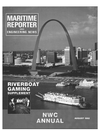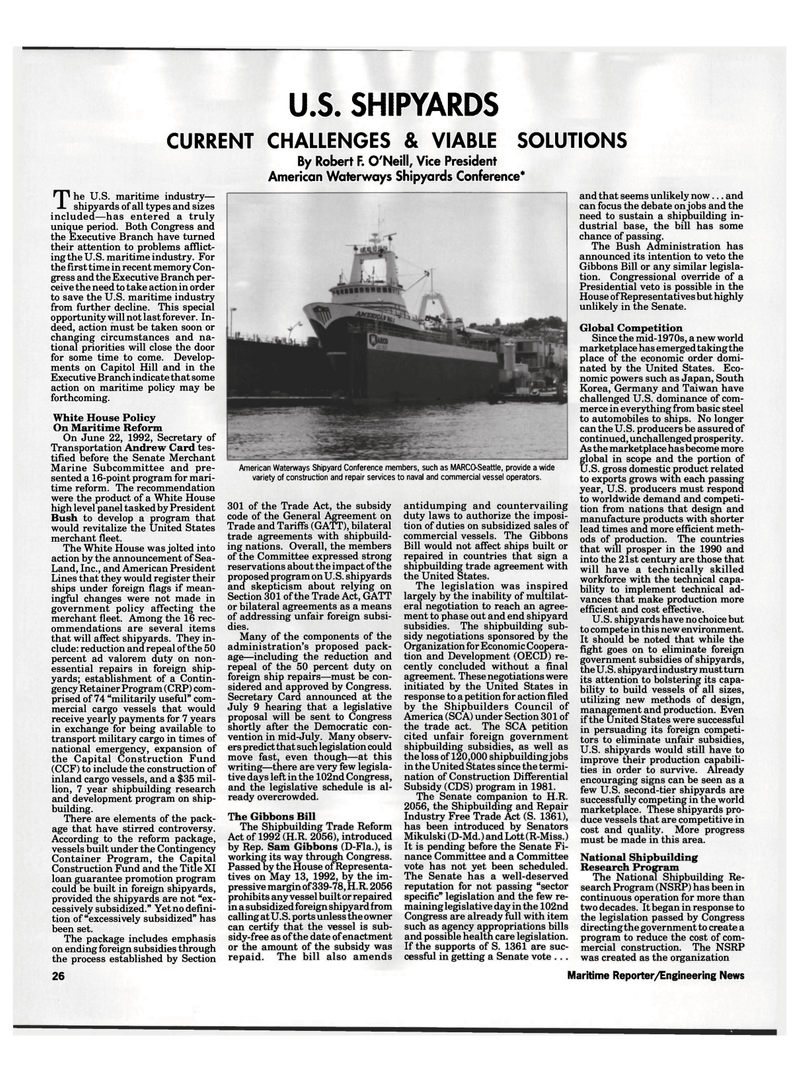
Page 24: of Maritime Reporter Magazine (August 1992)
Read this page in Pdf, Flash or Html5 edition of August 1992 Maritime Reporter Magazine
U.S. SHIPYARDS
CURRENT CHALLENGES & VIABLE SOLUTIONS
By Robert F. O'Neill, Vice President
American Waterways Shipyards Conference*
The U.S. maritime industry— shipyards of all types and sizes included—has entered a truly unique period. Both Congress and the Executive Branch have turned their attention to problems afflict- ing the U.S. maritime industry. For the first time in recent memory Con- gress and the Executive Branch per- ceive the need to take action in order to save the U.S. maritime industry from further decline. This special opportunity will not last forever. In- deed, action must be taken soon or changing circumstances and na- tional priorities will close the door for some time to come. Develop- ments on Capitol Hill and in the
Executive Branch indicate that some action on maritime policy may be forthcoming.
White House Policy
On Maritime Reform
On June 22, 1992, Secretary of
Transportation Andrew Card tes- tified before the Senate Merchant
Marine Subcommittee and pre- sented a 16-point program for mari- time reform. The recommendation were the product of a White House high level panel tasked by President
Bush to develop a program that would revitalize the United States merchant fleet.
The White House was jolted into action by the announcement of Sea-
Land, Inc., and American President
Lines that they would register their ships under foreign flags if mean- ingful changes were not made in government policy affecting the merchant fleet. Among the 16 rec- ommendations are several items that will affect shipyards. They in- clude: reduction and repeal of the 50 percent ad valorem duty on non- essential repairs in foreign ship- yards; establishment of a Contin- gency Retainer Program (CRP) com- prised of 74 "militarily useful" com- mercial cargo vessels that would receive yearly payments for 7 years in exchange for being available to transport military cargo in times of national emergency, expansion of the Capital Construction Fund (CCF) to include the construction of inland cargo vessels, and a $35 mil- lion, 7 year shipbuilding research and development program on ship- building.
There are elements of the pack- age that have stirred controversy.
According to the reform package, vessels built under the Contingency
Container Program, the Capital
Construction Fund and the Title XI loan guarantee promotion program could be built in foreign shipyards, provided the shipyards are not "ex- cessively subsidized." Yet no defini- tion of "excessively subsidized" has been set.
The package includes emphasis on ending foreign subsidies through the process established by Section 26
American Waterways Shipyard Conference members, such as MARCO-Seattle, provide a wide variety of construction and repair services to naval and commercial vessel operators. 301 of the Trade Act, the subsidy code of the General Agreement on
Trade and Tariffs (GATT), bilateral trade agreements with shipbuild- ing nations. Overall, the members of the Committee expressed strong reservations about the impact of the proposed program on U.S. shipyards and skepticism about relying on
Section 301 of the Trade Act, GATT or bilateral agreements as a means of addressing unfair foreign subsi- dies.
Many of the components of the administration's proposed pack- age—including the reduction and repeal of the 50 percent duty on foreign ship repairs—must be con- sidered and approved by Congress.
Secretary Card announced at the
July 9 hearing that a legislative proposal will be sent to Congress shortly after the Democratic con- vention in mid-July. Many observ- ers predict that such legislation could move fast, even though—at this writing—there are very few legisla- tive days left in the 102nd Congress, and the legislative schedule is al- ready overcrowded.
The Gibbons Bill
The Shipbuilding Trade Reform
Act of 1992 (H.R. 2056), introduced by Rep. Sam Gibbons (D-Fla.), is working its way through Congress.
Passed by the House of Representa- tives on May 13, 1992, by the im- pressive margin of339-78, H.R. 2056 prohibits any vessel built or repaired in a subsidized foreign shipyard from calling at U.S. ports unless the owner can certify that the vessel is sub- sidy-free as of the date of enactment or the amount of the subsidy was repaid. The bill also amends antidumping and countervailing duty laws to authorize the imposi- tion of duties on subsidized sales of commercial vessels. The Gibbons
Bill would not affect ships built or repaired in countries that sign a shipbuilding trade agreement with the United States.
The legislation was inspired largely by the inability of multilat- eral negotiation to reach an agree- ment to phase out and end shipyard subsidies. The shipbuilding sub- sidy negotiations sponsored by the
Organization for Economic Coopera- tion and Development (OECD) re- cently concluded without a final agreement. These negotiations were initiated by the United States in response to a petition for action filed by the Shipbuilders Council of
America (SCA) under Section 301 of the trade act. The SCA petition cited unfair foreign government shipbuilding subsidies, as well as the loss of 120,000 shipbuilding jobs in the United States since the termi- nation of Construction Differential
Subsidy (CDS) program in 1981.
The Senate companion to H.R. 2056, the Shipbuilding and Repair
Industry Free Trade Act (S. 1361), has been introduced by Senators
Mikulski (D-Md.) and Lott (R-Miss.)
It is pending before the Senate Fi- nance Committee and a Committee vote has not yet been scheduled.
The Senate has a well-deserved reputation for not passing "sector specific" legislation and the few re- maining legislative day in the 102nd
Congress are already full with item such as agency appropriations bills and possible health care legislation.
If the supports of S. 1361 are suc- cessful in getting a Senate vote . . . and that seems unlikely now... and can focus the debate on jobs and the need to sustain a shipbuilding in- dustrial base, the bill has some chance of passing.
The Bush Administration has announced its intention to veto the
Gibbons Bill or any similar legisla- tion. Congressional override of a
Presidential veto is possible in the
House of Representatives but highly unlikely in the Senate.
Global Competition
Since the mid-1970s, a new world marketplace has emerged taking the place of the economic order domi- nated by the United States. Eco- nomic powers such as Japan, South
Korea, Germany and Taiwan have challenged U.S. dominance of com- merce in everything from basic steel to automobiles to ships. No longer can the U.S. producers be assured of continued, unchallenged prosperity.
As the marketplace has become more global in scope and the portion of
U.S. gross domestic product related to exports grows with each passing year, U.S. producers must respond to worldwide demand and competi- tion from nations that design and manufacture products with shorter lead times and more efficient meth- ods of production. The countries that will prosper in the 1990 and into the 21st century are those that will have a technically skilled workforce with the technical capa- bility to implement technical ad- vances that make production more efficient and cost effective.
U.S. shipyards have no choice but to compete in this new environment.
It should be noted that while the fight goes on to eliminate foreign government subsidies of shipyards, the U.S. shipyard industry must turn its attention to bolstering its capa- bility to build vessels of all sizes, utilizing new methods of design, management and production. Even if the United States were successful in persuading its foreign competi- tors to eliminate unfair subsidies,
U.S. shipyards would still have to improve their production capabili- ties in order to survive. Already encouraging signs can be seen as a few U.S. second-tier shipyards are successfully competing in the world marketplace. These shipyards pro- duce vessels that are competitive in cost and quality. More progress must be made in this area.
National Shipbuilding
Research Program
The National Shipbuilding Re- search Program (NSRP) has been in continuous operation for more than two decades. It began in response to the legislation passed by Congress directing the government to create a program to reduce the cost of com- mercial construction. The NSRP was created as the organization
Circle 258 on Reader Service Card Maritime Reporter/Engineering News

 23
23

 25
25
